|
|
|
Sort Order |
|
|
|
Items / Page
|
|
|
|
|
|
|
| Srl | Item |
| 1 |
ID:
134400
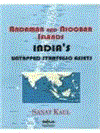

|
|
|
|
|
| Publication |
New Delhi, Pentagon Press, 2015.
|
| Description |
xii, 212p.Hbk
|
| Contents |
In association with Institute for Defence Studies and Analyses
|
| Standard Number |
9788182747746
|
|
|
|
|
|
|
|
|
|
|
|
Copies: C:2/I:0,R:0,Q:0
Circulation
| Accession# | Call# | Current Location | Status | Policy | Location |
| 057904 | 954.88/KAU 057904 | Main | On Shelf | General | |
| 057905 | 954.88/KAU 057905 | Main | On Shelf | General | |
|
|
|
|
| 2 |
ID:
151385


|
|
|
|
|
| Summary/Abstract |
The previous Abbott government had prioritized a general attitude to foreign policy captured by the phrase “Jakarta not Geneva,” which signified a preference for bilateral or minilateral interactions with the region rather than United Nations-based multilateralism. With Julie Bishop MP as Australia’s first female foreign minister, the Coalition also prioritized economic diplomacy, as exemplified by the repeated refrain that Australia is “open for business.”
This approach led to a preference for diplomatic venues and processes that focused on continuing investments in regional architecture, new emphasis on minilateral dialogues such as the Indian Ocean Rim Association (IORA) and Mexico, Indonesia, Korea, Turkey, and Australia (MIKTA), and more effort directed to bilateral and plurilateral processes such as the Trans-Pacific Partnership trade negotiations. This approach has been continued under Prime Minister Turnbull, with a renewed focus on innovation.
Part 1 considers minilateral and regional investments in the Indo-Pacific region, primarily, IORA, the Asia-Pacific Economic Cooperation (APEC), and the Association of South East Asian Nations (ASEAN). I consider MIKTA a unique vehicle for Australian diplomacy. Part 2 considers what issues Australia should be pursuing through these forums, with a focus on the two themes of gender equality (as an example of niche diplomacy) and trade (multilateralism under pressure) as case studies.
|
|
|
|
|
|
|
|
|
|
|
|
|
|
|
|
| 3 |
ID:
147980
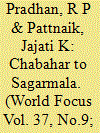

|
|
|
|
|
| Summary/Abstract |
India’s maritime space both externally and internally is under serious churning today. Caught between maritime forces and strategies building around South China Sea to Indo-Pacific region and the corresponding American ‘Asia Pivot’, India is riding maritime high table diplomacy in the neighbourhood sea lanes to protect and safeguard her strategic maritime assets and interests. Chabahar is one such India’s strategic naval diplomacy in the Persian Gulf. While the national and international media is agog with this maritime volatility and the corresponding stake holder countries moves and counter moves, India’s silent but strategic internal maritime space redrawing through ‘Sagarmala Project’ - India’s internal maritime connect grand strategy is not only a vision but a silent connectivity revolution in India’s coastal corridor towards an efficient maritime economy and efficiency.
|
|
|
|
|
|
|
|
|
|
|
|
|
|
|
|
| 4 |
ID:
193457
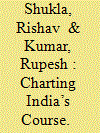

|
|
|
|
|
| Summary/Abstract |
The Indo-Pacific region stands as a crucial arena for global politics and trade, and India’s role in this context is increasingly significant. As the article highlights, India’s maritime strategy is influenced by a delicate balancing act between regional cooperation, economic interests, and national security concer ns. The impor tance of India’s evolving partnerships with key players in the Indo- Pacific, such as the United States, Japan, and Australia, as well as its engagement with regional forums like the Quad.
|
|
|
|
|
|
|
|
|
|
|
|
|
|
|
|
| 5 |
ID:
167739
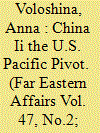

|
|
|
|
|
| Summary/Abstract |
In 2011, the U.S. Obama Administration officially put forward a geopolitical initiative that went down in history under the name of "pivot," or rebalance. A major element of that strategy, which was intended to guarantee U.S.A.'s dominant position in the Asia-Pacific Region (APR), became the building of constructive relations with China. This paper attempts to show how the Chinese vector of the pivot occurred and developed. Our analysis has yielded a conclusion about the changes that the pivot has undergone with the replacement of the U.S. administrations and also prompted a question about the efficiency of this strategy in terms of carrying out the objectives set by the United States.
|
|
|
|
|
|
|
|
|
|
|
|
|
|
|
|
| 6 |
ID:
177287
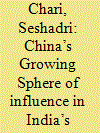

|
|
|
|
|
| Summary/Abstract |
China’s growth story and its cascading effects on world economy and more importantly the power shift has been a subject of serious study not only in the academic world but also among the strategic community. The exponential economic growth and expanding sphere of influence of China in the region, India’s extended neighbourhood and in the decision making bodies of the world is increasingly being seen as a challenge to the preeminent position of the US in the global power structure. The shift in China’s economic growth pattern post US economic crisis and its rising strategic influence since the end of Cold War and the disintegration of the Soviet Union can be interpreted as watershed moments in the changing dynamics of world order.
|
|
|
|
|
|
|
|
|
|
|
|
|
|
|
|
| 7 |
ID:
179233
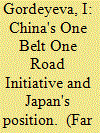

|
|
|
|
|
| Summary/Abstract |
This article deals with Japan's reaction to the One Belt One Road initiative put forward by China and formation of Japanese strategy toward the PRC under new conditions. We analyze Indo-Pacific region conception developed by Japan and the United States. There are attempts to involve India in the creation of an anti-Chinese "Quartet" of states that includes the United States, Japan and Australia. Alternative economic programs of Japan, its struggle with China for influence in Southeast Asia, and Tokyo's attempts to prevent "Chinese expansion" in the South China Sea are discussed. Attention is drawn to the fact that Japanese society is increasingly in favor of establishing economic cooperation with Beijing in the countries of the region.
|
|
|
|
|
|
|
|
|
|
|
|
|
|
|
|
| 8 |
ID:
154587
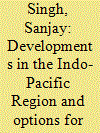

|
|
|
|
|
| Summary/Abstract |
Globalisation and increasing connectivity have compacted South Asia, East
Asia, Australasia, and South East Asia into a composite Indo-Pacific region,
inter-linked by ASEAN (Association of South East Asian Nations), both
physically as well as institutionally. Globalisation has also catalysed rapid Asian
economic growth, which has propelled a shift in the global centre of gravity
to the region.
|
|
|
|
|
|
|
|
|
|
|
|
|
|
|
|
| 9 |
ID:
170764
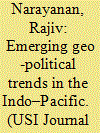

|
|
|
|
|
| Summary/Abstract |
The Indo-Pacific Region (IPR) is witnessing a major flux in the geo-political and geo-strategic spheres as there is a gradual shift in the maritime trade centre of gravity towards IPR from the Atlantic and the Pacific Regions. With the West and the USA perceived to be in a strategic retreat, it opens a window of opportunity in the region for a geo-strategic reconstruct. China, the resident major power, is keen to seize this opportunity to gain influence in the region. Xi Jinping sees this geo-political flux as an opportunity for China to assert itself within the Indo-Pacific. Towards that end, he has clubbed the existing infrastructure projects, and added a few, under the much touted ‘Belt Road Initiative (BRI)’ with the aim of gaining geopolitical space in Asia.
The article provides an analysis of the US and the Chinese strategies and the emerging trends for the Indo-Pacific and their implications for India and the way ahead.
|
|
|
|
|
|
|
|
|
|
|
|
|
|
|
|
| 10 |
ID:
192517
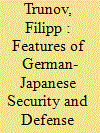

|
|
|
|
|
| Summary/Abstract |
Historically, both Germany and Japan have played significant roles in establishing a new world order. Today, the two countries are actively influencing the transformation of the "collective West" and its relations with the non-West. The role played in these processes by official Berlin, as well as by Tokyo, could considerably increase if they establish multi-channel and comprehensive security and defense cooperation. This paper seeks to explore the peculiarities and prospects of such cooperation in the early 2020s.
|
|
|
|
|
|
|
|
|
|
|
|
|
|
|
|
| 11 |
ID:
180400
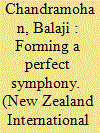

|
|
|
|
|
| Summary/Abstract |
Balaji Chandramohan comments on Joe Biden's presidency and its strategic impact in the Indo-Pacific region.
|
|
|
|
|
|
|
|
|
|
|
|
|
|
|
|
| 12 |
ID:
166119
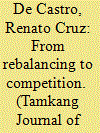

|
|
|
|
|
| Summary/Abstract |
During his two terms as U.S. president, former President Barack Obama made the Asia- Pacific region the focal point of American strategic attention. In November 2011, he announced the U.S. pivot to Asia. His goal was to constrain China from easing out the U.S. as East Asia's strategic offshore balancer. Contrary to expectations, the 2016 election of Donald Trump, did not spell the end of the strategic rebalancing to Asia. For the Trump Administration, the Asia-Pacific remains a top security priority for two reasons. One, North Korea's nuclear weapons program poses a clear and present danger to the U.S. and its allies in Northeast Asia. And two, China's naval expansion, island-building activities, and militarization efforts in the South China Sea threaten not only the freedom of navigation but also the rules-based international order. In conclusion, the article argues that there is a great deal of consistency between the Obama Administration's strategic rebalancing and the Trump Administration's emerging Indo-Pacific Strategy. However, the current administration's Indo-Pacific strategy reflects both continuity as well as discontinuity with its predecessor's rebalancing policy. On the one hand, neither U.S. national security interests nor Asia's importance to Washington has changed in the Trump Administration. On the other hand, its policy also reflects discontinuity as it characterized China as a threat to U.S. interests and is geared to engage this emergent power in a long strategic competition in the Indo-Pacific region.
|
|
|
|
|
|
|
|
|
|
|
|
|
|
|
|
| 13 |
ID:
187332
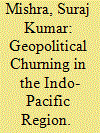

|
|
|
|
|
| Summary/Abstract |
In the Indo-Pacific, tensions between China and the U.S., Australia, India and others are building momentum with China’s escalating actions in the wake of the COVID-19 catastrophe which has shaken Indo-Pacific geopolitics considerably. As a geopolitical partnership, the relevance of the Quad is now proven. The Indo-Pacific seems to have come of age. The rise of India and China, as well as the ensuing great-power competition and deepening economic links across the Asia-Pacific and the Indian Ocean regions are often seen as a reality. The geopolitical strategic endeavour about the perceived ‘rise of China’ is viewed by influential observers and practitioners, particularly in the USA, Australia, Japan and India as a churning in Indo-Pacific region. China’s growing influence in Asia, the ‘Indo-Pacific’ is not an innocent or neutral description, but is a manufactured super-region designed to hedge against a perceived Sino-centric regional order.
|
|
|
|
|
|
|
|
|
|
|
|
|
|
|
|
| 14 |
ID:
164118


|
|
|
|
|
| Summary/Abstract |
Adecade back Asia-Pacific and South Asia defined two separate regions. The growth of India and its relevance to Asia-Pacific was perhaps first recognised by the Japanese Prime Minister Abe when speaking at the Indian Parliament in August 2007. He said, “My friends, where exactly do we now stand historically and geographically? To answer this question, I would like to quote here the title of a book authored by the Mughal prince Dara Shikoh in 1655. We are now at a point at which the Confluence of the Two Seas is coming into being. The Pacific and the Indian Oceans are now bringing about a dynamic coupling as seas of freedom and of prosperity. A “broader Asia” that broke away geographical boundaries is now beginning to take on a distinct form. Our two countries have the ability and the responsibility to ensure that it broadens yet further and to nurture and enrich these seas to become seas of clearest transparence.”
|
|
|
|
|
|
|
|
|
|
|
|
|
|
|
|
| 15 |
ID:
142688
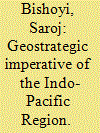

|
|
|
|
|
| Summary/Abstract |
The global economic power shift from the West to East (Asia) and the increasing geostrategic significance of the Indo-Pacific region has resulted in cooperation and competition among the established and rising powers in the region. While the economic cooperation between them has significantly grown in recent past, the geostrategic and geopolitical frameworks remain very uncertain. In essence, the emerging trends and issues in the Indo-Pacific offer unique opportunities as well as daunting challenges to the nations. These developments have generated great interest and debate among the researchers, academics as well as policymakers circles across the world.
|
|
|
|
|
|
|
|
|
|
|
|
|
|
|
|
| 16 |
ID:
184952
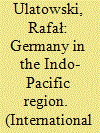

|
|
|
|
|
| Summary/Abstract |
In the twenty-first century, the Indo-Pacific region became the focal point of great power competition. In 2020, Germany published its ‘Policy guidelines for the Indo-Pacific. Germany—Europe—Asia: shaping the twenty-first century together’. The publication of the Indo-Pacific guidelines and the deployment of frigate Bayern to the Indo-Pacific in early August 2021 offer a starting point for a discussion on a German grand strategy in the post-liberal world order. This article argues that the publication of the German Indo-Pacific guidelines and Germany's increased engagement in the region are a consequence of a change in how Germany perceives China. In the first decade of the twenty-first century, the rise of China was seen as an opportunity for Germany, but this has changed, with China now increasingly seen as a threat to Germany's national interests. Consequently, Germany is strengthening its cooperation with like-minded countries in Asia and is engaging in soft balancing against China. Germany's Defence Minister Annegret Kramp-Karrenbauer stops short of using the word alliance, calling for ‘an international network of like-minded countries’ and also stops short of declaring a containment strategy against China, saying that Germany works together with China where this is possible, but digs its heels in against China where it has to.
|
|
|
|
|
|
|
|
|
|
|
|
|
|
|
|
| 17 |
ID:
188395
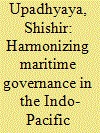

|
|
|
|
|
| Summary/Abstract |
Maritime safety and security remains an area of concern in the Indo-Pacific region, a vast integrated maritime space bound by trade and shipping connectivity. While multiple organizations have evolved over the years to address the various threats and challenges at the sub-regional level, the absence of an overarching institution that could synergize these efforts to improve wider maritime governance has hampered overall efforts. This article explains how such an ‘umbrella’ organization could be created to enhance maritime safety and security in the Indo-Pacific region.
|
|
|
|
|
|
|
|
|
|
|
|
|
|
|
|
| 18 |
ID:
158616
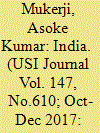

|
|
|
| 19 |
ID:
175381


|
|
|
|
|
| Summary/Abstract |
India’s Engagements in the Indo-Pacific Region has been growing quite fast with like- minded countries and this paper focuses on India’s relations with Australia which ride basically on the economic relations as economics and trade provide the synergy for developing other partnerships.
|
|
|
|
|
|
|
|
|
|
|
|
|
|
|
|
| 20 |
ID:
181493
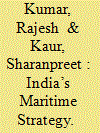

|
|
|
|
|
|
|
|